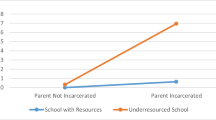Abstract
This study examined aspects of the school, community, and home adjustment of 58 adolescents between the ages of 13 and 20 whose mothers were incarcerated. High rates of school drop-out (36%) were observed. Dropping out was related to their mother's educational attainment. These adolescents were more than four times as likely to be out of school than a sample of their best friends; four times more likely to be suspended; three times more likely to be significantly absent from school and nearly four times as likely to be failing classes. More than half of these children required school visits for disciplinary reasons during the previous 12 months, and more than a quarter of them had been arrested. School problems and delinquent behavior might be related to the extent of maternal drug use. Although these adolescents initially experienced difficulty adapting to structured placements, those who were living in homes with rules and with family members had better educational outcomes, as did children who communicated frequently with their mothers.
Similar content being viewed by others
References
Alemagno, S. A. (2001). Women in jail: Is substance abuse treatment enough?.American Journal of Public Health, 91, 798–800.
Bednar, S. G. (2001). Reuniting families and breaking the cycle: A research note.Marriage & Family Review, 33, 107–112.
Chesney-Lind, M. (1986). Women and crime: The female offender.Signs, 12, 78–96.
Church, G. J. (1978). On prisoners and parenting: Preserving the tie that binds.Yale Law Review, 87, 1408–1429.
Duiguid, S., & Pawson, R. (1998). Education, change, and transformation: The prison experience.Evaluation Review, 22, 470–495.
Erez, E. (1988). The myth of the new female offender Some evidence from attitudes toward law and justice.Journal of Criminal Justice, 16, 499–509.
Fogel, C. I., & Martin, S. L. (1992). The mental health of incarcerated women. Western Journal of Nursing Research, 14, 30–47.
Harm, N. J., & Phillips, S. D. (2001). You can't go home again: Women and criminal recidivism.Journal of Offender Rehabilitation, 32, 3–21.
Hawley, T. L., Halle, T. G., Drasin, R. E., & Thomas, N. G. (1995). Children of addicted mothers: Effects of the “crack” epidemic on the caregiving environment and the development of preschoolers.American Journal of Orthopsychiatry, 65, 364–376.
Huey, V. A. (1993). Mom's in prison—Where are the kids?.USA Today Magazine, 122, 30–32.
Mowbray, C. T., Oyserman, D., Zemencuk, J. K., & Ross, S. R. (1995). Motherhood for women with serious mental illness: Pregnaney, childbirth, and the postpartum period,American Journal of Orthopsychiatry, 65, 21–30.
Showers, J. (1993). Assessing and remedying parenting knowledge among women inmates.Journal of Offender Rehabilitation, 20, 35–46.
Simon, R. J. (1975).The Contemporary woman and crime. Rockville, MD: National Institute of Mental Health.
Solomon, P., & Draine, J. (1995). Subjective burden among family members of mentally ill adults: Relation to stress, coping, and adaptation.American Journal of Orthopsychiatry, 65, 419–429.
Stein, L., & Mistiaen, V. (1988). Pregnant in prison.The Progressive, 31, 18–21.
Trice, A. D., & Lamb, M. (1996). Sex-role orientation among incarcerated women. Psychological Reports, 79, 92–94.
Weis, J. (1978).Liberation and crime: The invention of the new female criminal. In P. Wickman & P. Whitten (Eds.), Readings in criminology. Lexington, MA: Heath.
Werner, D. R. (1990).Correctional education: Theory and practice. Danville, IL: Interstate Press.
Wooldredge, J. D., & Masters, K. (1993). Confronting problems faced by pregnant inmates in stafe prisons.Crime and Delinquency, 39, 195–203.
Author information
Authors and Affiliations
Additional information
Authors' Note: This research was supported by grants from the American Bar Association and the Fund for the Improvement of Post Secondary Education, US Department of Education.
Rights and permissions
About this article
Cite this article
Trice, A.D., Brewster, J. The effects of maternal incarceration on adolescent children. J Police Crim Psych 19, 27–35 (2004). https://doi.org/10.1007/BF02802572
Issue Date:
DOI: https://doi.org/10.1007/BF02802572



